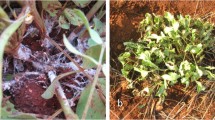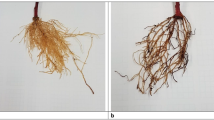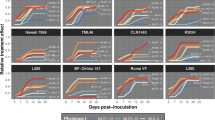Abstract
Macrophomina phaseolina is a typical soilborne fungal pathogen causing crown and root rot in strawberry (Fragaria × ananassa Duch.) worldwide. M. phaseolina has become a major problem for strawberry growers parallel to the phase-out of methyl-bromide since 2004 and is considered the most destructive soilborne pathogen of strawberry since then. Global warming is characterized by extreme weather conditions, in the Mediterranean area, as reflected by long, hot, dry summers without rain and relatively short, cold rainy winters. This together with regulatory restrictions on toxic fumigants creates favorable conditions for M. phaseolina to thrive. Screening for resistant germplasm is currently the most effective and sustainable approach for managing the disease. In order to screen for susceptible/tolerant strawberry cultivars, various inoculation techniques were assessed on five strawberry cultivars. Artificial inoculation of growth medium with naturally infected plant material and the use of the ‘toothpick’ method resulted in no significant differences. However, the use of artificially produced sclerotia in a soil mix at concentrations of 2.5 × 103 sclerotia/g soil exhibited differential cultivar mortality rates. High variation was found among 32 tested strawberry varieties (Israeli and US) grown under outdoor conditions in a screenhouse. Cultivars ‘Pelican’ (US), ‘Orly’, ‘Tamir’ and ‘Rotmy’ were considered tolerant compared to cultivars ‘Florida 90’ (US) and ‘Peles’ that were the most susceptible. The overall results indicate that the choice of certain Israeli and US cultivars may provide future germplasm for resistance breeding against M. phaseolina.



Similar content being viewed by others
References
Abawi, G. S., & Pastor-Corrales, M. A. (1990). Root rots of beans in Latin America and Africa: Diagnosis, research methodologies, and management strategies. Cali: Centro Internacional de Agricultura Tropical.
Albajes, R., Gullino, M. L., Van Lenteren, J. C., & Elad, Y. (1999). Integrated pest and diseases management in greenhouse crops. Dordrecht: Kluwer Academic Publishers.
Angelini, R., & Nad Faedi, W. (2010). Malattie e fisiopatie. In: ART Servizi (ed.) La Fragola (pp. 228–246). Bologna, Italy.
Avilés, M., Castillo, S., Bascon, J., Zea-Bonilla, T., Martín-Sánchez, P. M., & Pérez-Jiménez, R. M. (2008). First report of Macrophomina phaseolina causing crown and root rot of strawberry in Spain. Plant Pathology, 57(2), 382–382.
Avilés, M., Castillo, S., Borrero, C., Castillo, M. L., Zea-Bonilla, T., & Pérez-Jiménez, R. M. (2009). Response of strawberry cultivars: ‘Camarosa’, ‘Candonga’ and ‘Ventana’ to inoculation with isolates of Macrophomina phaseolina. VI International Strawberry Symposium. Acta Horticulturae, 842, 291–294.
Baggio, J. S., Cordova, L. G., & Peres, N. A. (2019). Sources of inoculum and survival of Macrophomina phaseolina in Florida strawberry fields. Plant Disease, 103, 2417–2424.
Bowers, G. R., & Russin, J. S. (1999). Soybean disease management. In L. G. Heatherly & H. F. Hodges (Eds.), Soybean production in the Midsouth. Boca Raton: CRC Press.
Carter, C. A., Chalfant, J. A., Goodhue, R. E., Han, F. M., & DeSantis, M. (2005). The methyl bromide ban: economic impacts on the California strawberry industry. Applied Economic Perspectives and Policy, 27(2), 181–197.
Chamorro, M., Miranda, L., Domínguez, P., Medina, J. J., Soria, C., Romero, F., López-Aranda, J. M., & De los Santos, B. (2015). Evaluation of biosolarization for the control of charcoal rot disease (Macrophomina phaseolina) in strawberry. Crop Protection, 67, 279–286.
Chamorro, M., Seijo, T. E., Noling, J. C., De los Santos, B., & Peres, N. A. (2016). Efficacy of fumigant treatments and inoculum placement on control of Macrophomina phaseolina in strawberry beds. Crop Protection, 90, 163–169.
Cohen, R., Elkabetz, M., & Edelstein, M. (2016). Variation in the responses of melon and watermelon to Macrophomina phaseolina. Crop Protection, 85, 46–51.
Dhingra, O. D., & Sinclair, J. B. (1975). Survival of Macrophomina phaseolina sclerotia in soil: effects of soil moisture, carbon: nitrogen ratios, carbon sources, and nitrogen concentrations. Phytopathology, 65, 236–240.
Duniway, J. M. (2002). Status of chemical alternatives to methyl bromide for pre-plant fumigation of soil. Phytopathology, 92, 1337–1343.
Fang, X. L., Phillips, D., Verheyen, G., Li, H., Sivasithamparam, K., & Barbetti, M. J. (2012). Yields and resistance of strawberry cultivars to crown and root diseases in the field and cultivar responses to pathogens under controlled environmental conditions. Phytopathologia Mediterranea, 51, 69–84.
Freeman, S., & Gnayem, N. (2005). Use of plasticulture for strawberry plant production. Small Fruits Review, 4, 21–32.
Freeman, S., & Katan, T. (1997). Identification of Colletotrichum species responsible for anthracnose and root necrosis of strawberry in Israel. Phytopathology, 87(5), 516–521.
Goldreich, Y. (2003). The climate of Israel: Observation, research and application. New York: Springer.
Gomez, A. O., De Faveri, J., Neal, J. M., Aitken, E. A. B., & Herrington, M. E. (2020). Response of strawberry cultivars inoculated with Macrophomina phaseolina in Australia. International Journal of Fruit Science, 1–14. https://doi.org/10.1080/15538362.2019.1709114.
Gupta, G. K., Sharma, S. K., & Ramteke, R. (2012). Biology, epidemiology and management of the pathogenic fungus Macrophomina phaseolina (Tassi) Goid with special reference to charcoal rot of soybean (Glycine max (L.) Merrill). Journal of Phytopathology, 160, 167–180.
Hummer, K. E., & Hancock, J. (2009). Strawberry genomics: botanical history, cultivation, traditional breeding, and new technologies. Genetics and Genomics of Rosaceae, 6, 413–435.
Hutton, D. G., Gomez, A. O., & Mattner, S. W. (2013). Macrophomina phaseolina and its association with strawberry crown rot in Australia. International Journal of Fruit Science, 13, 149–155.
Kaur, S., Dhillon, G. S., Brar, S. K., Vallad, G. E., Chand, R., & Chauhan, V. B. (2012). Emerging phytopathogen Macrophomina phaseolina: biology, economic importance and current diagnostic trends. Critical Reviews in Microbiology, 38(2), 36–151.
Koike, S. T. (2008). Crown rot of strawberry, caused by Macrophomina phaseolina, in California. Plant Disease, 92(8), 1253.
Koike, S. T., Arias, R. S., Hogan, C. S., Martin, F. N., & Gordon, T. R. (2016). Status of Macrophomina phaseolina on strawberry in California and preliminary characterization of the pathogen. International Journal of Fruit Science, 16, 148–159.
Lisker, N., & Meiri, A. (1992). Control of Rhizoctonia solani damping-off in cotton by seed treatment with fungicides. Crop Protection, 11(2), 155–159.
Mayek-Pérez, N., López-Castañeda, C., López-Salinas, E., Cumpián-Gutiérrez, J., & Acosta-Gallegos, J. A. (2001). Macrophomina phaseolina resistance in common bean under field conditions in Mexico. Agrociencia, 46, 649–661.
Mertely, J., Seijo, T., & Peres, N. (2005). First report of Macrophomina phaseolina causing a crown rot of strawberry in Florida. Plant Disease, 89(4), 434.
Meyer, W. A., Sinclair, J. B., & Khare, M. N. (1974). Factors affecting charcoal rot of soybean seedlings. Phytopathology, 64(6), 845–849.
Mihail, J. D., Rush, C. M., & Singleton, L. L. (1992). Methods for research on soilborne phytopathogenic fungi. The American Phytopathological Society.
Ndiaye, M., Termorshuizen, A. J., & Van Bruggen, A. H. C. (2007). Combined effects of solarization and organic amendment on charcoal rot caused by Macrophomina phaseolina in the Sahel. Phytoparasitica, 35, 392–400.
Nelson, J., Verma, S., Peres, N., & Whitaker, V. (2019). QTL discovery for resistance to charcoal rot caused by Macrophomina phaseolina in strawberry (Fragaria×ananassa). 9th North American Strawberry Symposium, Orlando, Florida, USA.
Ozkilinc, H., Frenkel, O., Shtienberg, D., Abbo, S., Sherman, A., Kahraman, A., & Can, C. (2011). Aggressiveness of eight Didymella rabiei isolates from domesticated and wild chickpea native to Turkey and Israel, a case study. European Journal of Plant Pathology, 131, 529–537.
Pecina-Quintero, V., Williams-Alanis, H., & Vandemark, G. J. (1999). Diallel analysis of resistance to Macrophomina phaseolina in sorghum. Cereal Research Communications, 27, 99–106.
Philosoph, A. M., Dombrovsky, A., Elad, Y., Jaiswal, A. K., Koren, A., Lachman, O., & Frenkel, O. (2018). Combined infection with cucumber green mottle mosaic virus and Pythium species causes extensive collapse in cucumber plants. Plant Disease, 102, 753–759.
Reuveni, R., Krikun, J., Nachmias, A., & Shlevin, E. (1982). The role of Macrophomina phaseolina in a collapse of melon plants in Israel. Phytoparasitica, 10, 51–56.
Saleh, A. A., Ahmed, H. U., Todd, T. C., Travers, S. E., Zeller, K. A., Leslie, J. F., & Garrett, K. A. (2010). Relatedness of Macrophomina phaseolina isolates from tallgrass prairie, maize, soybean and sorghum. Molecular Ecology, 19, 79–91.
Sánchez, S., Henríquez, J. L., Urcola, L. A., Scott, A., & Gambardella, M. (2016). Susceptibility of strawberry cultivars to root and crown rot caused by Macrophomina phaseolina. Journal of Berry Research, 6(3), 345–354.
Sharma, G., Maymon, M., & Freeman, S. (2017). Epidemiology, pathology and identification of Colletotrichum including a novel species associated with avocado (Persea americana) anthracnose in Israel. Scientific Reports, 7, 15839.
Sharon, M., Freeman, S., Kuninaga, S., & Sneh, B. (2007). Genetic diversity, anastomosis groups and virulence of Rhizoctonia spp. from strawberry. European Journal of Plant Pathology, 117(3), 247–265.
Singh, S. K., Nene, Y. L., & Reddy, M. V. (1990). Influence of cropping systems on Macrophomina phaseolina populations in soil. Plant Disease, 74, 812–814.
Smith, B., Gupton, C. L., Galetta, G. J., Maas, J. L., Enns, J. M., Ballington Jr., J. R., Constantin, R. J., DiVittorio, T. J., & Himelrick, D. (1998). ‘Pelican’ strawberry. HortScience, 33, 1082–1084.
Strand, L. L. (1994). Integrated pest management for strawberries. Oakland: University of California Press.
Yildiz, A., Benlioğlu, S., Boz, Ö., & Benlioğlu, K. (2010). Use of different plastics for soil solarization in strawberry growth and time–temperature relationships for the control of Macrophomina phaseolina and weeds. Phytoparasitica, 38, 463–473.
Zveibil, A., & Freeman, S. (2005). First report of crown and root rot in strawberry caused by Macrophomina phaseolina in Israel. Plant Disease, 89, 1014–1014.
Zveibil, A., & Freeman, S. (2009). Methods for detection of soilborne pathogens affecting strawberry in Israel. VI International Strawberry Symposium. Acta Horticulturae, 842, 191–194.
Zveibil, A., Mor, N., Gnayem, N., & Freeman, S. (2012). Survival, host–pathogen interaction, and management of Macrophomina phaseolina on strawberry in Israel. Plant Disease, 96, 265–272.
Acknowledgements
We thank Prof. Dani Shtienberg for advice regarding statistical analyses of the data; Dr. Roni Cohen, Mr. Zcharia Tanami, Ms. Edna Ben Arie, Mr. Menachem Borenstein, Ms. Dalia Rav-David and Mr. Ran Shulhani for support with greenhouse, screenhouse experiments, and logistics.
Funding
This research was partially funded by the Chief Scientist of the Israeli Ministry of Agriculture, award # 132–1821.
Author information
Authors and Affiliations
Corresponding author
Ethics declarations
Mention of trade names or commercial products in this publication is solely for the purpose of providing specific information and does not imply recommendation or endorsement by the authors.
Conflict of interest
The authors declare no conflict of interest.
Rights and permissions
About this article
Cite this article
Pickel, B., Dai, N., Maymon, M. et al. Development of a reliable screening technique for determining tolerance to Macrophomina phaseolina in strawberry. Eur J Plant Pathol 157, 707–718 (2020). https://doi.org/10.1007/s10658-020-02051-4
Accepted:
Published:
Issue Date:
DOI: https://doi.org/10.1007/s10658-020-02051-4




